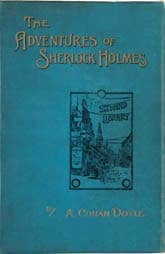The Adventures of Sherlock Holmes
Critique • Quotes • Text • Sherlock Holmes at the movies
 First edition
First editionFirst publication
1892
Literature form
Story collection
Genres
Crime, mystery
Writing language
English
Author's country
England
Length
Twelve stories, approx. 94,000 words
The great sleuth in his prime
When we're talking about Arthur Conan Doyle's contribution to detective literature, we really mean the entire oeuvre of fifty-six Sherlock Holmes stories, plus four Holmes novels. But if you're looking for a single-volume introduction to the famous works, The Adventures of Sherlock Holmes (1892) is a good choice, as it presents Doyle's detective character fully fledged—and includes some of his most intriguing mysteries.
At this point in the canon, before The Adventures, Holmes had already appeared in two novels, starting with A Study in Scarlet, in which Dr. Watson had first met Holmes but the detective was featured for less than half the story. The Sign of Four had developed Holmes's persona and surroundings further.
The Adventures of Sherlock Holmes then gets right down to it, with its twelve short stories pitting the sleuth and his narrating sidekick against some of his best puzzles and cleverest enemies.
Chances are, however, you won't easily find this particular volume but will more likely lay your hands on a collection of Sherlockiana that includes several stories from The Adventures of Sherlock Holmes along with some from later volumes, namely The Memoirs of Sherlock Holmes, The Return of Sherlock Holmes, His Last Bow and The Case-Book of Sherlock Holmes. Which isn't necessarily a bad thing, because there are great Holmes entries in each of these volumes. Better yet, pick up a complete works (they're cheap enough now) and delve into them at will.
Most of the stories appeared in The Strand Magazine in London before being collected into book volumes. They do follow some kind of chronology—though "Watson" jumps around a bit with the order, which gives Holmes fanatics (whose numbers are legion the job of figuring out when in real time each of the fictions is thought to have taken place. But it isn't at all required to read the stories as given in order to appreciate them.
However, two of the most popular—and enduring—Holmes tales lead off The Adventures of Sherlock Holmes.
Much copied
The first Adventure, "A Scandal in Bohemia," brings him up against the woman who will always be the woman to Holmes. You may already be familiar with this story as it is often singled out for film and television treatment and it has been much copied.
Doyle's story is itself a variation on a much earlier detective story, Edgar Allan Poe's The Purloined Letter of 1845. For most readers though, Doyle's version is better. It's not the greatest mystery, hardly a mystery at all, but an entertaining tale of police work, almost a thriller.
The second story in the volume, "The Red-Headed League", is a real head-scratcher, a mystery with one of Doyle's clever solutions that seems obvious after it is revealed—an irony Holmes himself points out in many a story.
It's a magician's trick of misdirection. If afterwards, the magician repeats the trick for you but at the crucial point points to where you should be looking to see how the trick is done.... Well, that was simple, wasn't it? Nothing magical about it.
Doyle ties up our attention with the strange job an oddly qualified fellow is hired to carry out and and we never come close to figuring out what's really going on behind the curtain. Until Holmes tells us, of course.
All the rest of the stories in The Adventures of Sherlock Holmes are worthy, though one particular story seems especially popular for movie and TV adaptation. "The Speckled Band" involves a...but if I tell you, you'll know the solution to the mystery.
This is one of the more atmospheric of Doyle's mysteries. Not one of my favourites though. It's hardly a case of Holmes reasoning his way to a solution. As far as I can make out, he makes a lucky guess on insufficient evidence. More of an adventure than a mystery.
Another story rated among the best is the lesser known collection closer "The Adventure of the Copper Beeches", a classic puzzler about a governess who is paid a handsome salary as long as she follows some peculiar instructions.
For the most part, these stories are individually ingenious as mysteries but also interesting, taken as a whole, for detailing the odd relationship between the arrogant, reclusive Holmes and the affable doctor, the purported chronicler of these cases.
What he said
By the way, in all these stories, the good doctor is never told by Holmes that any piece of detection is "Elementary, my dear Watson."
Nor are the words uttered together in any other works by Arthur Conan Doyle. They were, rather, stitched together later by writers adapting Sherlock Holmes to stage and film. The movies also ring myriad other changes on his character that you won't detect in Doyle's original work.
— Eric
Critique • Quotes • Text • Sherlock Holmes at the movies

